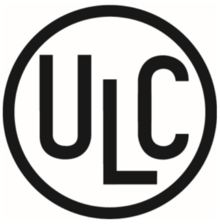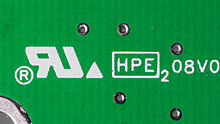
Safety is the state of being "safe", the condition of being protected from harm or other danger. Safety can also refer to the control of recognized hazards in order to achieve an acceptable level of risk.

IEC 60320 Appliance couplers for household and similar general purposes is a set of standards from the International Electrotechnical Commission (IEC) specifying non-locking connectors for connecting power supply cords to electrical appliances of voltage not exceeding 250 V (a.c.) and rated current not exceeding 16 A. Different types of connector are specified for different combinations of current, temperature and earthing requirements. Unlike IEC 60309 connectors, they are not coded for voltage; users must ensure that the voltage rating of the equipment is compatible with the mains supply. The standard uses the term coupler to encompass connectors on power cords and power inlets and outlets built into appliances.

A fire alarm notification appliance is an active fire protection component of a fire alarm system. A notification appliance may use audible, visible, or other stimuli to alert the occupants of a fire or other emergency condition requiring action. Audible appliances have been in use longer than any other method of notification. Initially, all appliances were either electromechanical horns or electric bells, which would later be replaced by electronic sounders. Most of today's appliances produce sound levels between 70 and 100 decibels at three feet.

The National Electrical Code (NEC), or NFPA 70, is a regionally adoptable standard for the safe installation of electrical wiring and equipment in the United States. It is part of the National Fire Code series published by the National Fire Protection Association (NFPA), a private trade association. Despite the use of the term "national," it is not a federal law. It is typically adopted by states and municipalities in an effort to standardize their enforcement of safe electrical practices. In some cases, the NEC is amended, altered and may even be rejected in lieu of regional regulations as voted on by local governing bodies.

A safe is a secure lockable enclosure used for securing valuable objects against theft or fire. A safe is usually a hollow cuboid or cylinder, with one face being removable or hinged to form a door. The body and door may be cast from metal or formed out of plastic through blow molding. Bank teller safes typically are secured to the counter, have a slit opening for dropping valuables into the safe without opening it, and a time-delay combination lock to foil thieves. One significant distinction between types of safes is whether the safe is secured to a wall or structure or if it can be moved around.

A fire door is a door with a fire-resistance rating used as part of a passive fire protection system to reduce the spread of fire and smoke between separate compartments of a structure and to enable safe egress from a building or structure or ship. In North American building codes, it, along with fire dampers, is often referred to as a closure, which can be derated compared against the fire separation that contains it, provided that this barrier is not a firewall or an occupancy separation. In Europe national standards for fire doors have been harmonised with the introduction of the new standard EN 16034, which refers to fire doors as fire-resisting door sets. Starting September 2016, a common CE marking procedure was available abolishing trade barriers within the European Union for these types of products. In the UK, it is Part B of the Building Regulations that sets out the minimum requirements for the fire protection that must be implemented in all dwellings this includes the use of fire doors. All fire doors must be installed with the appropriate fire resistant fittings, such as the frame and door hardware, for it to fully comply with any fire regulations.
ETL SEMKO is a division of Intertek Group plc which is based in London. It specializes in electrical product safety testing, EMC testing, and benchmark performance testing. ETL SEMKO operates more than 30 offices and laboratories on six continents. SEMKO was, until 1990, the body responsible for testing and certifying electric appliances in Sweden. The "S" mark was mandatory for products sold in Sweden until the common European CE mark was adopted prior to Sweden's accession to the European Union.

A carbon monoxide detector or CO detector is a device that detects the presence of the carbon monoxide (CO) gas to prevent carbon monoxide poisoning. In the late 1990s Underwriters Laboratories changed the definition of a single station CO detector with a sound device to carbon monoxide (CO) alarm. This applies to all CO safety alarms that meet UL 2034 standard; however for passive indicators and system devices that meet UL 2075, UL refers to these as carbon monoxide detectors. Most CO detectors use a sensor with a defined, limited lifespan, and will not work indefinitely.

UL 94, the Standard for Safety of Flammability of Plastic Materials for Parts in Devices and Appliances testing, is a plastics flammability standard released by Underwriters Laboratories of the United States. The standard determines the material's tendency to either extinguish or spread the flame once the specimen has been ignited. UL-94 is now harmonized with IEC 60695-11-10 and 60695-11-20 and ISO 9772 and 9773.

A fire alarm system is a building system designed to detect, alert occupants, and alert emergency forces of the presence of fire, smoke, carbon monoxide, or other fire-related emergencies. Fire alarm systems are required in most commercial buildings. They may include smoke detectors, heat detectors, and manual fire alarm activation devices. All components of a fire alarm system are connected to a fire alarm control panel. Fire alarm control panels are usually found in an electrical or panel room. Fire alarm systems generally use visual and audio signalization to warn the occupants of the building. Some fire alarm systems may also disable elevators, which are unsafe to use during a fire under most circumstances.
A firestop or fire-stopping is a form of passive fire protection that is used to seal around openings and between joints in a fire-resistance-rated wall or floor assembly. Firestops are designed to maintain the fire-resistance rating of a wall or floor assembly intended to impede the spread of fire and smoke.
An alarm monitoring center, central monitoring station, or alarm receiving center is a company that provides services to monitor burglar, fire, and residential alarm systems. The Central Monitoring Station may also provide watchman and supervisory services.
The Air Movement and Control Association International, Inc. (AMCA) is an American trade body that sets standards for Heating, Ventilation and Air Conditioning (HVAC) equipment. It rates fan balance and vibration, aerodynamic performance, air density, speed and efficiency.

A fire test is a means of determining whether fire protection products meet minimum performance criteria as set out in a building code or other applicable legislation. Successful tests in laboratories holding national accreditation for testing and certification result in the issuance of a certification listing.

A power entry module (PEM) is an electromechanical component used in electrical appliances, integrating the appliance inlet with other components such as:
A certification listing is a document used to guide installations of certified products, against which a field installation is compared to make sure that it complies with a regulation. Typically, products or items are required to be installed or used in accordance with a subject-related certification listing if those products or items are subject to product certification and must be used in a specific manner in order to be safe for use. Certification listings are issued by organisations that are usually nationally accredited for doing both testing and product certification work, in accordance with nationally accredited standards.
Nationally Recognized Testing Laboratory is the term used by the United States Occupational Safety and Health Administration to identify third-party organizations that have the necessary qualifications to perform safety testing and certification of products covered within OSHA and each organization's scopes. The testing and certification are conducted in accordance with U.S. consensus-based product safety test standards developed or issued by U.S. standards organizations
The Underwriters Laboratories' UL 2610 is a comprehensive safety standard that governs the construction, performance, operation, and maintenance of security alarm systems and units for commercial premises, such as mercantile and banking locations. The standard details requirements for a range of alarm systems including central station burglar alarms, police station connected alarms, local alarms, proprietary systems, holdup alarms, and digital alarm communicator system units. It also covers power supplies essential for burglar-alarm equipment operation.
The Underwriters Laboratories' UL 365 is a safety standard that governs the construction, performance, and maintenance of police station-connected burglar alarm units and systems. These systems are designed primarily for use in mercantile premises, including mercantile safes and vaults, as well as bank safes and vaults.
The Underwriters Laboratories' UL 294 is a safety standard that addresses the construction, performance, and operation of access control systems intended to regulate or control entry into and exit from secured areas. These systems can also restrict access to certain devices through electrical, electronic, or mechanical means. The standard is designed to ensure that these systems are constructed, perform, and operate effectively to secure sensitive or restricted areas. Many organizations will require products to be certified to exclude non-compliant systems from acquisition. This makes it an important standard for manufacturers to comply with.


















